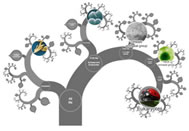Tiny fossils upend timeline of multicellular life (Science, 26 Jan 2024) - A new study describing a microscopic, algalike fossil dating back more than 1.6 billion years supports the idea that one of the hallmarks of the complex life we see around us - multicellularity - is much older than previously thought. >> Learn More
An ancient bacterial gene sets the stage for human sight (14 Apr 2023) - The eye is so complex that Charles Darwin was at a loss to explain how it could have arisen. It now turns out that the evolution of the vertebrate eye got an unexpected boost—from bacteria, which contributed a key gene involved in the retina’s response to light. The work, reported this week in the Proceedings of the National Academy of Sciences, drives home the evolutionary importance of genes borrowed from other species.>> Read More
 The OneZoom tree of life explorer shows how all life on our planet is related.Each leafrepresents a different species. The branches show how these many species evolved from common ancestors over billions of years. In this interactive tree of life, you can explore the relationships between 2,235,076 species (as of March 2022) and wonder at over 105,360 images on a single zoomable page.
A brief introduction on its use can be found HERE
The OneZoom tree of life explorer shows how all life on our planet is related.Each leafrepresents a different species. The branches show how these many species evolved from common ancestors over billions of years. In this interactive tree of life, you can explore the relationships between 2,235,076 species (as of March 2022) and wonder at over 105,360 images on a single zoomable page.
A brief introduction on its use can be found HERE
 Since Darwin's The Descent of Man was published in 1871, it has been the foundation of human evolutionary studies.
Since Darwin's The Descent of Man was published in 1871, it has been the foundation of human evolutionary studies.
In their article in the 21 May 2021 issue of the journal Science, entitled "Modern theories of human evolution foreshadowed by Darwin’s Descent of Man" P. Richerson, S. Gavrilets, and F. de Waal review how modern studies of human biological and cultural evolution closely reflect the ideas in Darwin's work. How cooperation, social learning, and cumulative culture in the ancestors of modern humans were key to our evolution. They point out that Darwin's evolutionary perspective has come to permeate not just human biology but also the social sciences, vindicating his original insights.
Discovery of evidence of fingers in the fossilized bones of a 380 million-year-old lobe-finned fish. This is the first unequivocal discovery of fingers locked in a fin with fin-rays in any known fishe fossil as described in the 18 March 2020 issue of Nature. An ancient Elpistostege fish fossil found in Miguasha, Canada it has revealed new insights into how the human handevolved from fish fins. An international team of palaeontologists from Flinders University (Australia) and Universite du Quebec describe a fish specimen that has yielded the missing evolutionary link in the fish to tetrapod transition, as fish began toexplore habitats such as shallow water and land during the Late Devonian period.>> Read more
Fossil shows how whales evolved from walkers to swimmers The fossils of a possible whale ancestor that walked on land 50 million years ago is giving us new insights on how whales evolved into swimmers, according to findings published the April 2019 issue of Current Biology. The fossil was found in Peru, and researchers think it may have made its way from West Africa, indicating quadrupedal whales already could survive such a long journey at sea.
Cell-like chemically active droplets may contain clues about origins of life. Chemically active droplets that grow and divide like cells may have been key to the origins of life, according to a study published in the December 2016 issue of Nature Physics. Chemically active droplets can exhibit cycles of growth and division that resemble the proliferation of living cells. "It makes it more plausible that there could have been spontaneous emergence of life from nonliving soup," said study co-author Frank Julicher.
Discovery of five new species of tetrapod that lived between 360 million and 345 million years ago may help bridge the gap of 15 million years in the tetrapod fossil record and reveal more about how creatures moved from aquatic life to living on land. The new species plus seven other fragmentary fossils are described in a study published in the December 5th 2016 issue of Nature Ecology & Evolution.
Evidence that Evolution Trends Towards Increasing Body Size - A new study of the evolution of marine animals has found evidence that Cope's Rule, which hypothesizes that animal lineages evolve toward larger body size over time, is true. The researchers analyzed data that spaned over 500 million years and included more than 17,000 marine animal species. They found that body volumes had increased by over five orders of magnitude since the first animals evolved. Modeling also suggested that such a massive increase could not have emerged from neutral drift from a small initial value. Science 2015, 347, 867-870.




